2003 Oldsmobile Alero fuel filter
[x] Cancel search: fuel filterPage 90 of 354
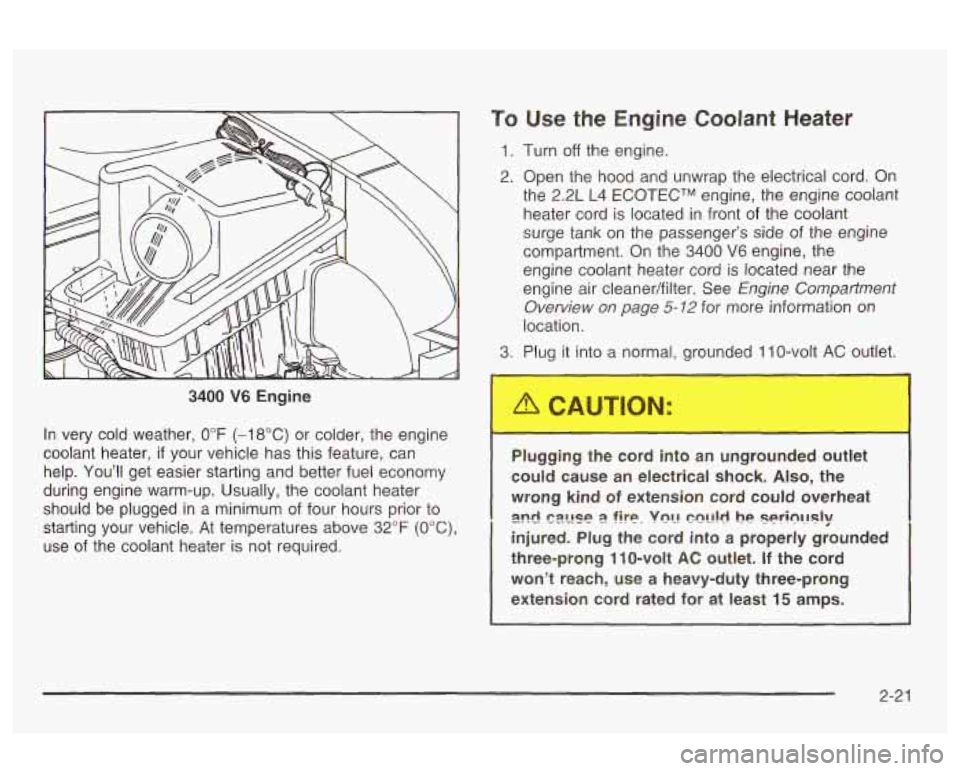
3400 V6 Engine
In very cold weather,
0°F (-18°C) or colder, the engine
coolant heater,
if your vehicle has this feature, can
help. You'll get easier starting and better fuel economy
during engine warm-up. Usually, the coolant heater
should be plugged in a minimum of four hours prior to
starting your vehicle. At temperatures above
32°F (OOC),
use of the coolant heater is not required.
To Use the Engine Coolant Heater
1. Turn off the engine.
2. Open the hood and unwrap the electrical cord. On
the 2.2L L4
ECOTECTM engine, the engine coolant
heater cord is located in front of the coolant
surge tank on the passenger's side
of the engine
compartment. On the
3400 V6 engine, the
engine coolant heater cord is located near the
engine air cleaner/filter. See
Engine Compartment
Overview on page
5-12 for more information on
location.
3. Plug it into a normal, grounded 1 IO-volt AC outlet.
Plugging the cord into an ungrounded ou' t
could cause an electrical shock. Also, the
wrong kind
of extension cord could overheat
injured. Plug the cord into a properly grounded
three-prong
11 0-volt AC outlet. If the cord
won't reach, use a heavy-duty three-prong
extension cord rated for at least
15 amps.
2nd !-?z!Jse 2 fire. VQL! C?!!!,! he Seri~IJsly
2-2 1
Page 216 of 354

Section 5 Service and Appearance Care
Service ........................................................... -5-3
Doing Your Own Service Work ......................... 5.4
Adding Equipment to the Outside
of Your
Vehicle
..................................................... -5-4
Fuel
............................................................... -5-5
Gasoline Octane ........................................... -5-5
Gasoline Specifications .................................... 5.5
California Fuel .............................................. -5-6
Additives
...................................................... -5-6
Fuels in Foreign Countries
.............................. -5-6
Filling Your Tank
..................................... 5-7
Fillins a Portable Fuel Container .. ...... 5.8
the Hood
...................................................... 5-9
Hood Release .............................................. 5-10
Engine Compartment Overview ....................... 5-12
Engine Oil
.................................................. -5-1 5
Au'romaiic Transaxie Fiuia A-LL
Manual Transaxle Fluid .................................. 5-22
Checking
Things Under
Engine Air CleanedFilter
................................ 5-21 - ^^ .............................
Hydraulic Clutch ........................................... 5-22
Engine Overheating
....................................... 5-26
Cooling System
............................................ 5-28
Power Steering Fluid
..................................... 5-35
Windshield Washer Fluid
............ ............ -5-36
Brakes
...................................................... -5-38
Battery
........................................................ 5-41
Jump Starting
.............................................. 5-42
Engine Coolant
............................................. 5-23
Headlamp Aiming
........................................... 5-47
Bulb Replacement .......................................... 5-49
Haloger;
!3L;lbs .............................................. 5-49
Headlamps .................. .... ......... 5-49
Front Turn Signal and
Parking Lamps
.......... ......... 5-50
Center High-Mounted Stoplamp (CHMSL)
.................................... 5-50
Taillamps, Turn Signal, and Stoplamps ............ 5-50 n-.-~ n ..II-- nepmwzIIIe111 DUIU~ J-J 1 rc4 .......................................
5- 1
Page 234 of 354
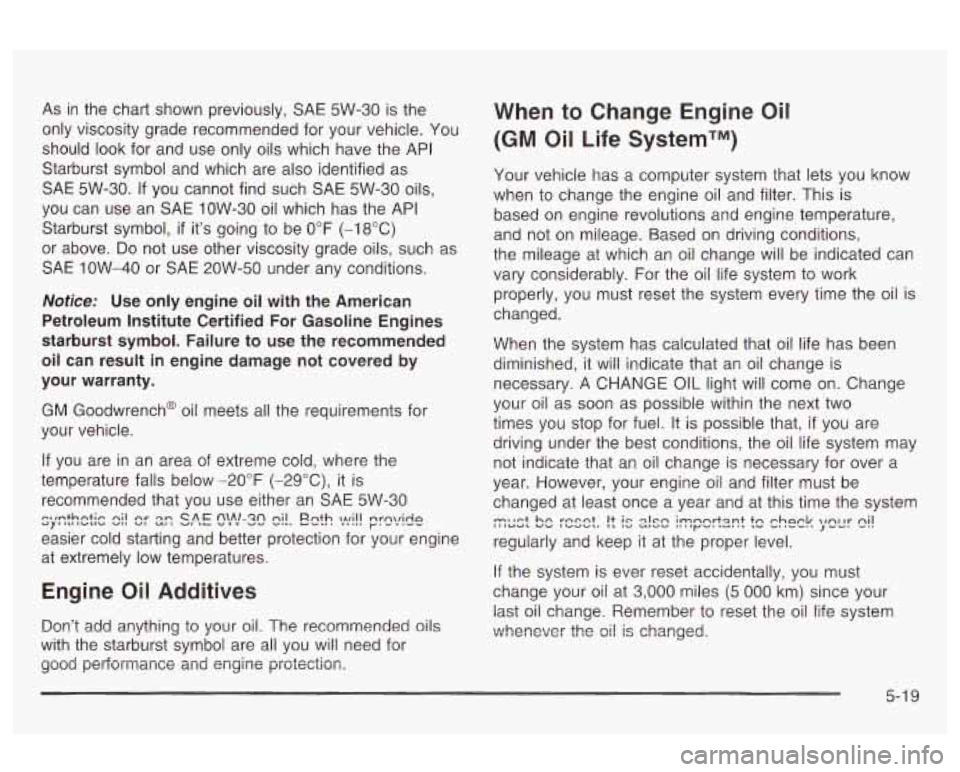
As in the chart shown previously, SAE 5W-30 is the
only viscosity grade recommended for your vehicle. You
should look for and use only oils which have the API
Starburst symbol and which are also identified as
SAE 5W-30.
If you cannot find such SAE 5W-30 oils,
you can use an SAE 1OW-30 oil which has the API
Starburst symbol,
if it’s going to be 0°F (-18°C)
or above.
Do not use other viscosity grade oils, such as
SAE 1OW-40 or SAE 20W-50 under any conditions.
Nofice: Use only engine oil with the American
Petroleum Institute Certified For Gasoline Engines
starburst symbol. Failure to use the recommended
oil can result in engine damage not covered by
your warranty.
GM Goodwrench@ oil meets all the requirements for
your vehicle.
If you are in an area of extreme cold, where the
temperature falls below -20°F (-29”C), it is
recommended that you use either an SAE 5W-30
easier cold starting and better protection for your engine
at extremely low temperatures.
s;.nthctic ci! cr 2:: sfl,E !-j\)!-zc e!!. Eeth ?.,I!!! nrn\/idn ra - - I--
Engine Oil Additives
Don’t add anything to your oil. The recommended oils
with the starburst symbol are all you will need for
good performance and engine protection.
When to Change Engine Oil
(GM
Oil Life SystemTM)
Your vehicle has a computer system that lets you know
when to change the engine oil and filter. This is
based on engine revolutions and engine temperature,
and not on mileage. Based
on driving conditions,
the mileage at which an oil change will be indicated can
vary considerably. For the oil life system to work
properly, you must reset the system every time the oil is
changed.
When the system has calculated that oil life has been
diminished, it will indicate that an oil change is
necessary. A CHANGE
OIL light will come on. Change
your oil as soon as possible within the next two
times you stop for fuel. It is possible that,
if you are
driving under the best conditions, the oil life system may
not indicate that an oil change is necessary for over a
year. However, your engine oil and filter must be
changed at least once a year and at this time the system
regularly and keep it at the proper level.
%Est !x rcsd. It is a!sc irr?pcrtz??t ?e check ;‘QL!T Qi!
If the system is ever reset accidentally, you must
change your oil at
3,000 miles (5 000 km) since your
last oil change. Remember to reset the oil life system
:vheneve: the ci! is changed.
5-1 9
Page 307 of 354
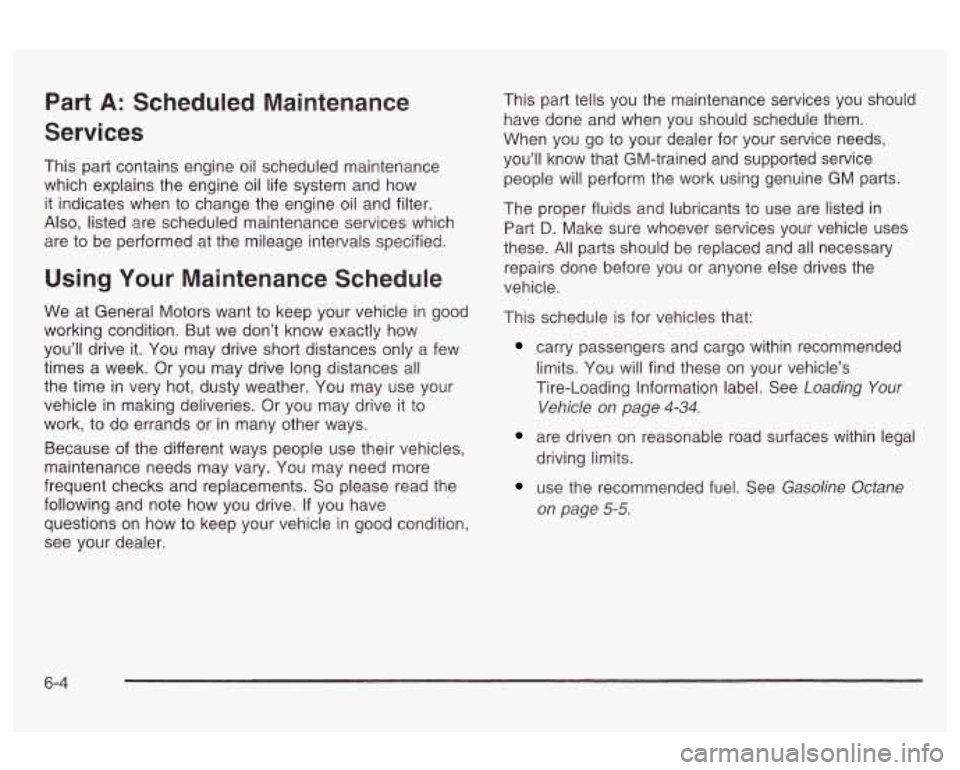
Part A: Scheduled Maintenance
Services
This part contains engine oil scheduled maintenance
which explains the engine oil life system and how
it indicates when to change the engine
oil and filter.
Also, listed are scheduled maintenance services which
are
to be performed at the mileage intervals specified.
Using Your Maintenance Schedule
We at General Motors want to keep your vehicle in good
working condition. But we don’t know exactly how
you’ll drive it. You may drive short distances only a few
times
a week. Or you may drive long distances all
the time in very hot, dusty weather. You may use your
vehicle in making deliveries. Or you may drive it to
work, to
do errands or in many other ways.
Because of the different ways people use their vehicles,
maintenance needs may vary. You may need more
frequent checks and replacements.
So please read the
following and note how you drive.
If you have
questions on how to keep your vehicle in good condition,
see your dealer. This part tells
you the maintenance services you should
have done and when you should schedule them.
When you go to your dealer for your service needs,
you’ll know that GM-trained and supported service
people will perform the work using genuine GM parts.
The proper fluids and lubricants to use are listed in
Part
D. Make sure whoever services your vehicle uses
these.
All parts should be replaced and all necessary
repairs done before you or anyone else drives the
vehicle.
This schedule is for vehicles that:
carry passengers and cargo within recommended
limits. You will find these on your vehicle’s
Tire-Loading Information label. See
Loading Your
Vehicle on page 4-34.
are driven on reasonable road surfaces within legal
driving limits.
use the recommended fuel. See Gasoline Octane
on page 5-5.
6-4
Page 308 of 354
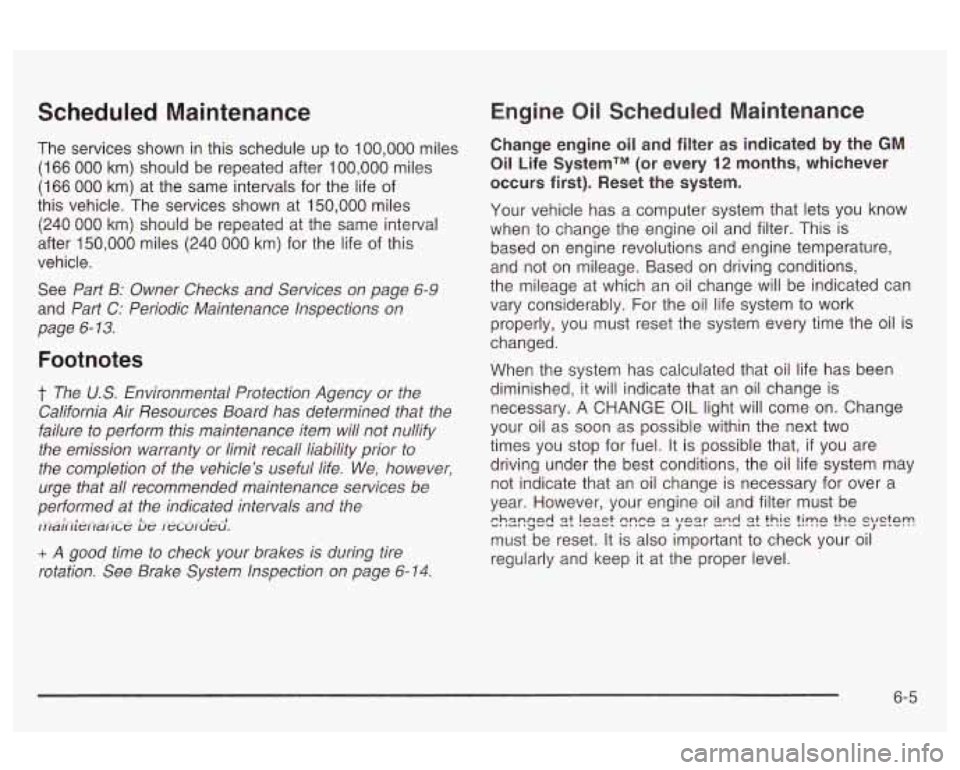
Scheduled Maintenance
The services shown in this schedule up to 100,000 miles
(1
66 000 km) should be repeated after 100,000 miles
(1
66 000 km) at the same intervals for the life of
this vehicle. The services shown at 150,000 miles
(240 000 km) should be repeated at the same interval
after 150,000 miles
(240 000 km) for the life of this
vehicle.
See
Part B: Owner Checks and Services on page 6-9
and Part C: Periodic Maintenance Inspections on
page
6- 13.
Footnotes
t The U.S. EfMrmmef%al Prdectim Agency or the
California Air Resources Board has determined that the
failure to perform this maintenance item will not nullify
the emission warranty or limit recall liability prior to
the completion of the vehicle's useful life. We, however,
urge that all recommended maintenance services be
performed at the indicated intervals and the
,iia;ii;eiiaiic.e be ,.ec.ui.u'eu'.
+ A good time to check your brakes is during tire
rotation. See Brake System Inspection on page
6-14.
Engine Oil Scheduled Maintenance
Change engine oil and filter as indicated by the GM
Oil Life SystemTM (or every 12 months, whichever
occurs first). Reset the system.
Your vehicle has a computer system that lets you know
when to change the engine oil and filter. This
is
based on engine revolutions and engine temperature,
and not on mileage. Based on driving conditions,
the mileage at which an oil change will be indicated can
vary considerably. For the oil life system to work
properly, you must reset the system every time the oil is
changed.
When the system has calculated that
oil life has been
diminished, it
wi!! indicate that an oil change is
necessary. A CHANGE OIL light will come on. Change
your oil as soon as possible within the next two
times you stop for fuel. It is possible that,
if you are
driving under the best conditions, the oil life system may
not indicate that an oil change is necessary for over a
year. However, your engine oil and filter must
be
must be reset. It is also important to check your oil
regularly and keep it at the proper level.
chs-mgd
!ezst s-ve 2 ye2r 2nd 2t this ?im,e the cwctam 'J -*-* ' *
6-5
Page 338 of 354
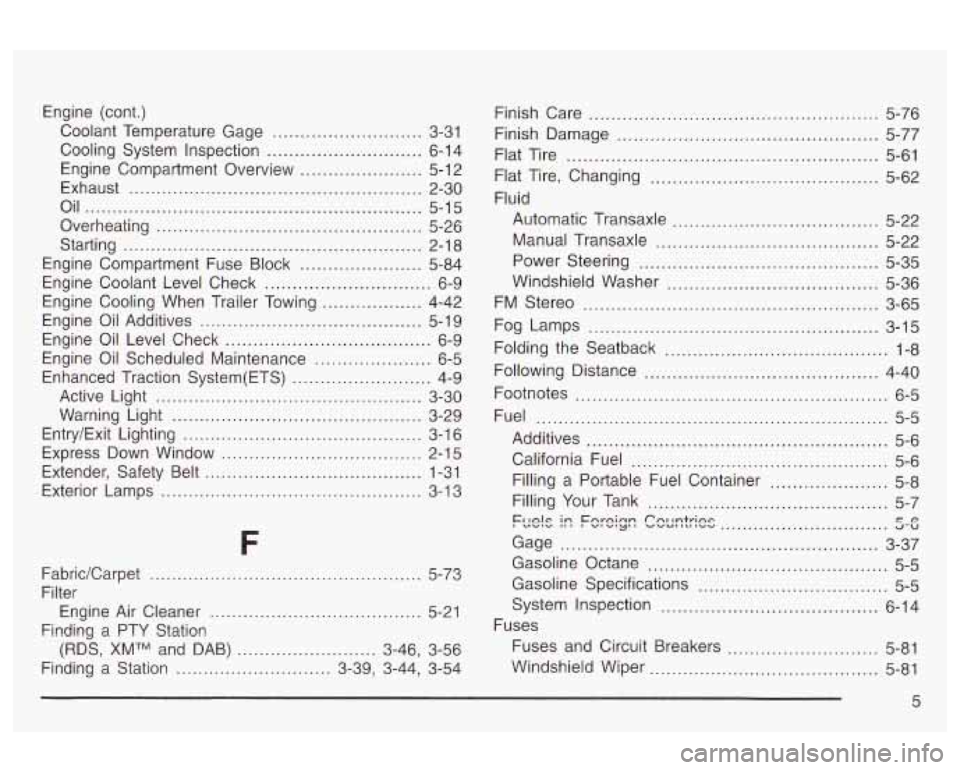
Engine (cont.) Coolant Temperature Gage
........................... 3-31
Cooling System Inspection ............................ 6-1 4
Engine Compartment Overview ...................... 5-1 2
Exhaust ..................................................... 2-30
Oil ............................................................. 5-15
Overheating ................................................ 5-26
Starting .................................................. 2-1 8
Engine Compartment Fuse Block .................. 5-84
Engine Coolant Level Check .............................. 6-9
Engine Cooling When Trailer Towing .................. 4-42
Engine Oil Additives ........................................ 5-19
Engine Oil Scheduled Maintenance ..................... 6-5
Enhanced Traction System(ETS) ......................... 4-9
Ac'rive Light ................................................ 3-30
Warning Light ............................................. 3-29
Entry/Exit Lighting ........................................... 3-1 6
Express Down Window .................................... 2-15
Extender, Safety Belt ....................................... 1-31
Exterior Lamps ............................................... 3-13
Engine Oil Level Check ..................................... 6-9
F
FabridCarpet ...............................
Filter
Engine Air Cleaner
.....
(RDS. XMTM and DAB) .... .............. 3.46. 3-56
Finding a Station ............................ 3-39, 3-44, 3-54
Finding a PTY Station
............
5-73
5-2
1
Finish Care ................................................ 5-76
Finish Damage ............................................... 5-77
Flat Tire ........................................................ 5-61
Flat Tire, Changing ......................................... 5-62
Fluid
Automatic Transaxle
.................. ........ 5-22
Manual Transaxle .................................... 5-22
Power Steering ........................................... 5-35
Windshield Washer ...................................... 5-36
Fog Lamps .................................................... 3-15
Folding the Seatback ........................................ 1-8
Footmtes ........................................................ 6-5
Fuel ............................................................... 5-5
Additives ...................................................... 5-6
California Fuel .............................................. 5-6
Filling a Portable Fuel Container ..................... 5-8
Filling Your -rank ........................................... 5-7
Gage ......................................................... 3-37
FM Stereo ..................................................... 3-65
Following Distance .......................................... 4-40
Fge!s i~ Fnminn Pnrrntrin c. "'V'Y" v"u"L"-U J-v cr? ..............................
Gasoline Octane ........................................... 5-5
Gasoline Specifications .................................. 5-5
System Inspection ....................................... 6-14
Fuses
Fuses and Circuit Breakers
........................... 5-81
Windshield Wiper ......................................... 5-81
5